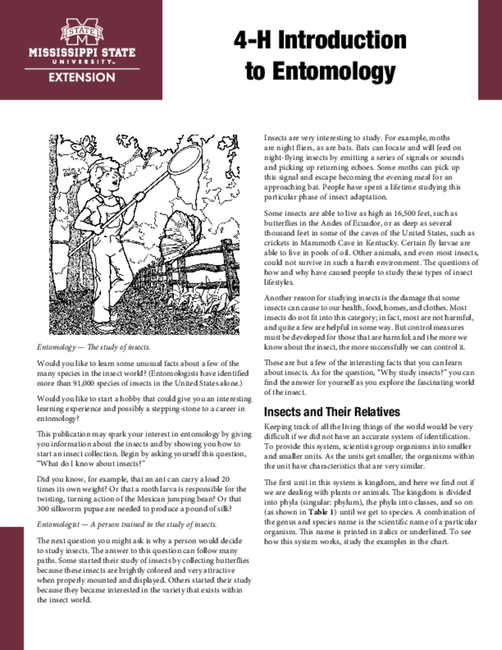4-H Introduction to Entomology
Entomology — The study of insects.
Would you like to learn some unusual facts about a few of the many species in the insect world? (Entomologists have identified more than 91,000 species of insects in the United States alone.)
Would you like to start a hobby that could give you an interesting learning experience and possibly a stepping-stone to a career in entomology?
This publication may spark your interest in entomology by giving you information about the insects and by showing you how to start an insect collection. Begin by asking yourself this question, “What do I know about insects?”
Did you know, for example, that an ant can carry a load 20 times its own weight? Or that a moth larva is responsible for the twisting, turning action of the Mexican jumping bean? Or that 300 silkworm pupae are needed to produce a pound of silk?
Entomologist — A person trained in the study of insects.
The next question you might ask is why a person would decide to study insects. The answer to this question can follow many paths. Some started their study of insects by collecting butterflies because these insects are brightly colored and very attractive when properly mounted and displayed. Others started their study because they became interested in the variety that exists within the insect world.
Insects are very interesting to study. For example, moths are night fliers, as are bats. Bats can locate and will feed on night-flying insects by emitting a series of signals or sounds and picking up returning echoes. Some moths can pick up this signal and escape becoming the evening meal for an approaching bat. People have spent a lifetime studying this particular phase of insect adaptation.
Some insects are able to live as high as 16,500 feet, such as butterflies in the Andes of Ecuador, or as deep as several thousand feet in some of the caves of the United States, such as crickets in Mammoth Cave in Kentucky. Certain fly larvae are able to live in pools of oil. Other animals, and even most insects, could not survive in such a harsh environment. The questions of how and why have caused people to study these types of insect lifestyles.
Another reason for studying insects is the damage that some insects can cause to our health, food, homes, and clothes. Most insects do not fit into this category; in fact, most are not harmful, and quite a few are helpful in some way. But control measures must be developed for those that are harmful; and the more we know about the insect, the more successfully we can control it.
These are but a few of the interesting facts that you can learn about insects. As for the question, “Why study insects?” you can find the answer for yourself as you explore the fascinating world of the insect.
Insects and Their Relatives
Keeping track of all the living things of the world would be very difficult if we did not have an accurate system of identification. To provide this system, scientists group organisms into smaller and smaller units. As the units get smaller, the organisms within the unit have characteristics that are very similar.
The first unit in this system is kingdom, and here we find out if we are dealing with plants or animals. The kingdom is divided into phyla (singular: phylum), the phyla into classes, and so on (as shown in Table 1) until we get to species. A combination of the genus and species name is the scientific name of a particular organism. This name is printed in italics or underlined. To see how this system works, study the examples in the chart.
|
Kingdom |
Plantae |
Animilia |
Animilia |
Animilia |
Animilia |
|---|---|---|---|---|---|
|
Phylum |
Magnoliaphyta |
Arthropoda |
Arthropoda |
Arthropoda |
Cordata |
|
Class |
Lilopsida |
Insecta |
Arachnida |
Malocostraca |
Mammalia |
|
Order |
Cyperales |
Lepidoptera |
Ixodida |
Decapoda |
Carnivora |
|
Family |
Poaceae |
Nymphalidae |
Ixodidae |
Cambaridae |
Felidae |
|
Genus |
Zea |
Danus |
Rhipicephalus |
Procambarus |
Felis |
|
Species |
mays |
plexippus |
sanguineus |
clarkia |
catus |
|
Common name |
corn |
monarch butterfly |
brown dog tick |
crawfish |
house cat |
Body Construction
As you can see, three out of the four examples in the animal kingdom have the same phylum name Arthropoda, and you have to go one more step before you separate this group of animals. The things that this group have in common are
- a segmented body
- jointed appendages
- a hard outer covering, or exoskeleton
The class Insecta differs from its relatives by having
- three body segments: head, thorax, abdomen
- three pairs of legs
- usually two pairs of wings (the flies have one pair, and several groups have lost their wings)
- one pair of antennae
Exoskeleton — The hard, outer body wall, or outside skeleton, of the insect. Think about your own body and where the skeleton is located. It’s found within your body and composed of bone.
Some other structures found on the insect body are the eyes, both simple and compound, and mouthparts. These structures are located on the head. The spiracles, or breathing ports, and the tympanum are located on the abdomen. The tympanum is the insect’s ear.
For practice, see how many of these structures you can locate and label on the drawing below. The answers are at the end of this publication, but don’t look before you try to find them by yourself.
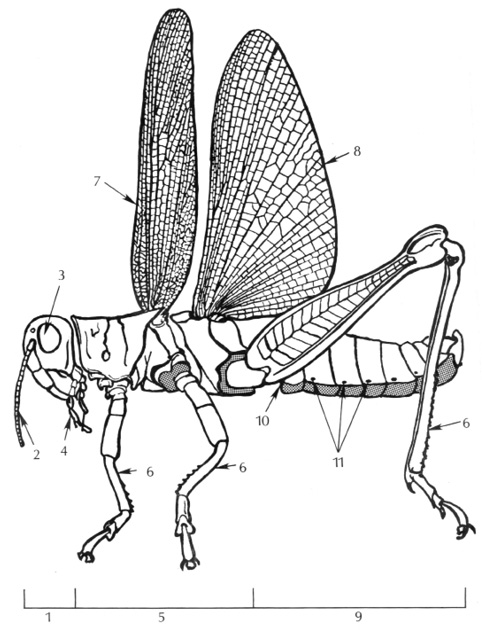
Insect Growth or Metamorphosis
Metamorphosis – The series of changes through which an insect passes in its growth from the egg to the adult; change in form.
The growth process that occurs in insects is quite different from that found in some of the other animal phyla. The process starts with the laying of an egg by a female insect. The eggs may be contained within a special structure call an ootheca, as found in roaches. They may be laid in masses and covered with body hairs and scales, as the fall armyworm moth, or they may be laid in a random pattern over a plant or scattered on the ground. In the aphids, the egg is retained within the body of the female until it hatches; this means the adult aphid gives birth to living young.
Ootheca – The covering, or case, over an egg mass, as in certain Blattodea (roaches).
Once the eggs hatch, the changes that particular insects may go through are called complete metamorphosis, gradual metamorphosis, incomplete metamorphosis, or without metamorphosis. Insects said to be without metamorphosis are classified for convenience because they undergo some change despite it not being easily seen. The two most common changes are the gradual and the complete metamorphoses.
Study the drawings on the right closely and observe the differences in the life cycles. Notice particularly the complete metamorphosis. Insects with this type of development undergo some radical changes, especially when changing from the larvae to the adults. The larvae are found in a much different habitat than are the adults—for example, the mosquito larva is aquatic and feeds on microorganisms, whereas the adult is a flying insect and feeds on blood. The change between these two life forms occurs during the pupal state.
List four types of metamorphoses that can occur within the world of the insect. 
Studying Insects
There are many ways to study insects. You might use live insects and make notes on their feeding habits, nest construction, potential as a damaging pest, or life cycle. Another way to study insects is by making an insect collection.
In order to make a good insect collection, there are several things you should know before starting: the equipment you will need, where to collect insects, and how to pin the insects and label your collection.
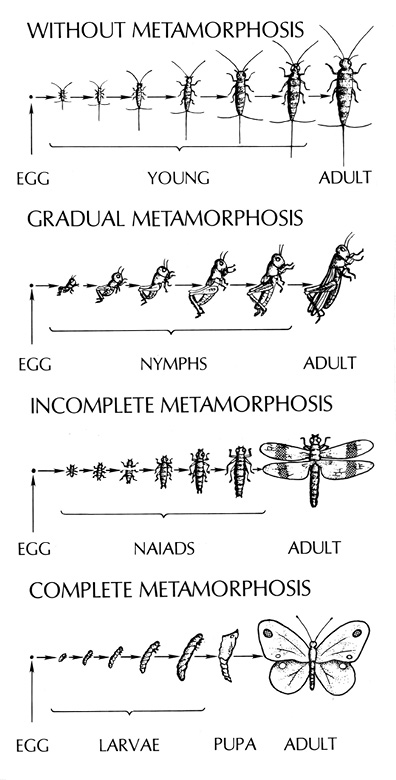
Equipment
These are the basics you will need to make your collection. Most of these items are simple and easy to make, or you can buy them from biological supply companies. See the reference section for examples of companies that supply these items.
Net
Nets are used to catch insects that fly or move very quickly. It is essentially a cloth bag, hung from a hoop that is attached to a handle. There are two types of nets: general purpose nets and sweep nets. The general purpose type is sometimes referred to as a butterfly or aerial net, and it is the one you will make and use. To make this type of net, you will need these items:
- A wooden handle, 3–4 feet long
- 4 feet of number 12 steel wire
- Two pieces of marquisette or nylon chiffon 22 ½ x 40 inches (or light-weight, unbleached muslin)
- Good, heavy-duty duct tape

You can make the handle from an old mop or broom. Remove the old head, and cut a groove along two opposite sides of the handle, starting the grooves from the cut end. One should be 3 ½ inches long, and the other should be 2½ inches long. Drill a small hole about one-fourth inch deep at the upper end of each groove.
Next, bend the wire into a circle about 12 inches in diameter. Leave enough wire on each end to make an arm—a 2 ½-inch-long arm on one side and a 3 ½-inch-long arm on the other side. These lengths correspond to the lengths of the grooves on the handle. Also, make two small hooks, about one-fourth inch long, at the ends of the wire. These hooks will fit into the holes you have drilled into the grooves on the handle.
To construct the net bag, fold two pieces of 22 ½ x 40-inch material to 11 ¼ x 40 inches. Cut through the material from the right bottom folded corner diagonally up and across to a point 10 inches from the top left unfolded corner. The material will be in two roughly triangular pieces.
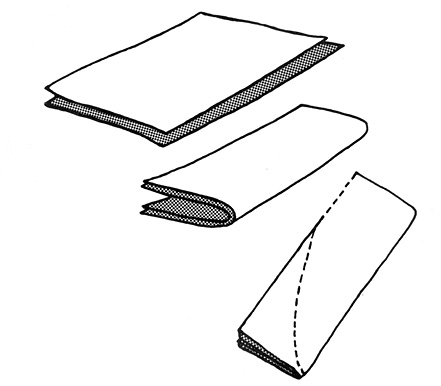
With face sides together, stitch the two big pieces of material along the cut edges, using a three-fourths inch seam allowance. Leave 10 inches free on one side at the top to make a casing where the wire hoop will be inserted. Turn the cut edges inside and stitch the seam down flat (flat-felled seam). To make a casing for the wire hoop, fold the top edge down 5 inches and stitch the lower edge in place.

If you use marquisette or nylon chiffon, you will need to reinforce the side seam and the top casing. To reinforce the side seam, use cotton twill tape when stitching. To reinforce the casing, underline the 10 inches at the bag top with a strip of muslin (cut 10 x 43 ½ inches). Then make the casing as instructed above.
You are now ready to put the bag on the hoop. Do this by slowly threading the wire hoop through the casing until the bag is completely supported by the wire. Attach the wire hoop to the handle by fitting the arms of the hoop into the grooves of the handle. Make sure the hooks are properly fitted into the drilled holes. Wrap the tape tightly around the handle, securing the wire arms of the hoop to the handle.
Kill jar
This piece of equipment is used to kill the insect quickly, once it has been caught. To construct the kill jar, you will need these items:
- A wide-mouthed jar
- Sawdust
- Plaster of paris
- Fingernail polish remover (ethyl acetate)
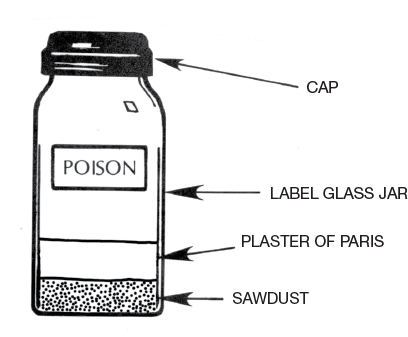
To make the jar, put 2–3 inches of dry sawdust into the jar. Mix 4–5 teaspoons of plaster of paris with water in a separate container. Do not make a soupy mixture but one that is just thin enough to pour. Slowly pour the wet plaster over the sawdust to a depth of about 1 ½ inch. Before using the jar, allow the plaster to dry for about 24 hours.
After the plaster is dry, the jar is ready for charging with fingernail polish remover. (Be sure to use fingernail polish remover that contains ethyl acetate.) Be very careful when handling this material because it can be dangerous. Pour a small amount of either liquid into the jar, and let it stand for several minutes. Pour off the excess, and the jar is ready to use.
Spreading board
The spreading board is used to spread the wings of butterflies and moths for display purposes. To build the board, you will need:
- Balsa wood, 2 pieces, 2 ½ x 16 inches
- Plywood support blocks, 2 pieces, ½ x 2 x 5 ½ inches
- Balsa wood, 1 piece, ½ inch square x 15 inches
- Glue
Begin by gluing the two large 16 x 2 ½ inch strips of balsa wood to the support blocks, being sure to leave a half-inch space between the two pieces. The smaller balsa wood strip (½ inch square x 15 inches) fits under the half-inch space and between the support blocks. This gives a pinning surface to use when spreading the wings of butterflies and moths. A spreading board may also be made from Styrofoam sheets, which are readily available from flower shops or department stores.
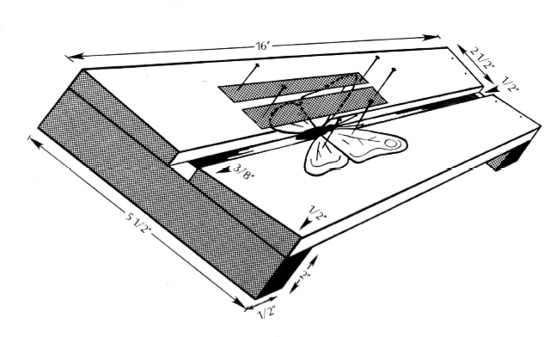
Pinning block
The pinning block is used to position the insect and date/locality label at a uniform height on the insect pin. You can make it using either a flat piece of wood or one cut in stair steps. Drill two holes, one-eighth inch in diameter, in the wood block. The first hole should be 1 inch deep and the second five-eighths inch deep. If the stair step arrangement is used, place the 1-inch deep hole on the highest step.
After placing the insect on the pin, insert the point of the pin in the deepest hole until it touches the bottom. The other hole is used to position the date/locality label.
Relaxing jar
It will be easy for you to pin an insect if you mount it right after you remove it from the kill jar. However, if the insect dries, it will be almost impossible to push the pin through its cuticle; its legs and antenna will be brittle and will often break when you try to pin it. Don’t throw the specimen away; save it by placing it in a relaxing jar.
To make this jar, use any wide-mouthed, screw-top jar. Place about 2–3 inches of sand in the bottom of the jar, and moisten it with water. Do not use so much water that it stands in the bottom of the jar. Add a small amount of rubbing alcohol or moth crystals to the moistened sand to help slow mold growth. Cover the sand with a cardboard disk. Place the specimen on the cardboard disk, and seal the jar. Specimens usually have to remain in the jar for about 24–48 hours before they are soft enough to mount.
Cuticle — The outer covering of an insect, comparable to your skin.
Insect pins
These pins are made especially for insect mounting and should be used instead of straight pins or sewing needles. The insect pins are uniform in size, and they will not rust. You can buy these pins in several different sizes from supply houses. A number 2 or 3 would be good for general use.
Standard Display Box
The standard 4-H display box is a storage unit for pinned insects, a display case, and if properly built and outfitted, a source of protection for collected specimens. The sturdy construction of the box protects the collection when you carry it from place to place. The more airtight the box, the more protected it will be from insect scavengers. To protect the insect collection from scavengers, put mothballs (or crystals) or an insect kill strip (Vapona strip) in the box. Attach the strip or the mothball in one corner of the box by using netting or insect pins. A small piece of kill strip gives good protection for several months.
As of July 1999, the dimensions for 4-H insect collection display boxes is standardized to 19 x 16 ½ x 3 inches (outside dimensions). This is the same size as the commercially available “Cornell drawers” that are most often used for institutional collections. This size is easy to handle and can be stored in standard insect cabinets. 4-H’ers can make their own collection boxes to match these dimensions, buy boxes built by local woodworkers, or purchase boxes from commercial suppliers. Commercially purchased Cornell drawers are more expensive, but they have tight-fitting lids that are easier and safer to handle than sliding glass lids. In any case, outside dimensions of the finished display box should be 19 x 16 ½ x 3 inches.
See the appendix for materials needed and instructions to make your own display box.
Holding Boxes
Almost any box with a secure top can serve as a temporary holding box for insect specimens. It is important to secure pinned specimens in a tight (airtight if possible) box soon after pinning. Scavengers can attack specimens and destroy a collection in a matter of weeks. Cigar boxes that are deeper than 2 inches make ideal holding boxes. In the bottom of the box, place a piece of flexible Styrofoam or another soft medium that will support a pin. Don’t forget to put a small piece of kill strip or a mothball in the box to protect against scavengers. To use mothballs, heat the head of an ordinary straight pin with a match while holding the pin with a pair of pliers. Insert the hot pinhead into the mothball and hold it steady for a few seconds.
You can adapt other sturdy boxes in much the same way. For short-term storage, use plastic boxes. Specimens tend to collect moisture and mold in these types of boxes, so you probably need to add silica packets to plastic containers when they are used for insect storage. You can build a holding box much like the standard display box, but you need to use a tight-fitting lid instead of glass.
For information on where to purchase insect collection boxes, contact the MSU Entomology and Plant Pathology Department at (662) 325-2085.
Where to Collect Insects
Insect activity is at its height during the warmer months of the year, but you can find certain insects during the colder months if you know where to look. During the warm season, you may notice two peaks of activity. The first will occur during late spring and early summer. At this time, all insects are out of overwintering sites, and the first one or two generations have matured. There may be somewhat of a decline during the hotter, drier months of summer and early fall. As temperatures cool in the fall, there will be another peak of activity as insects prepare to enter overwintering sites.
In making a general insect collection, the name of the game is variety. You should work toward having insects from each order and as many families from each order as your box will hold in a neat and orderly fashion. This will be a very challenging goal. To accomplish it, you will need to collect in as many different places as possible. Your imagination is your only limiting factor. Here are a few places you might try:
- under boards, rocks, or other objects that are lying on the ground (ants, crickets, beetles, termites, earwigs)
- in the air on warm, sunny days (wasps, bees, flies, beetles, butterflies)
- along the edges of streams, lakes, or ponds and in the water (mayflies at certain times of the year, dragonflies, aquatic beetles, aquatic true bugs)
- in houses (cockroaches, silverfish, ants, booklice)
- on domestic animals (fleas, lice, horn flies, horse flies)
- around lights (moths, beetles, true bugs, mosquitoes)
- around or on flowers and other ornamental plants (aphids, gall insects, beetles, walkingsticks, butterflies)
- around vegetable gardens (beetles, aphids, stink bugs, grasshoppers, flies, moths, praying mantises)
- manure piles (flies, beetles)
- in wood (bark beetles, wood borers, praying mantises, termites, butterflies)
- woodpiles (this is a good location to look for insects after cold weather arrives—stink bugs, darkling beetles, roaches)
- decaying stumps, logs (beetles, termites, ants)

When you are out collecting insects, be aware that other animals, such as snakes and spiders, are also active during the warmer months of the year. You might see snakes at several of the above locations, especially around ponds and lakes or in wooded areas. The spiders that you should be on the lookout for are the black widow and the brown recluse. The black widow may be found around woodpiles or under rocks and boards, and the brown recluse will be found in old buildings, such as abandoned houses or barns.
How to Mount Insects
Specimens are mounted to make storage easier and to further study. The specimens may be mounted in several ways:
- Body pinning. The insect is mounted directly onto the pin. Examples of insects that may be mounted by this method are bees, wasps, grasshoppers, crickets, beetles, dragonflies, roaches, moths, and butterflies.
- Card point. In this method, the pin is passed through the base of a card point and the insect is mounted on the tip of the point with a very small amount of glue. Use this method to mount insects too small to be pinned through the body. This group includes many of the smaller insects, such as beetles, flies, true bugs, ants, and leafhoppers.
- Slide mounts. Use this method to mount very small insects that have soft bodies. Examples are scales, aphids, trips, and lice. This method requires specific instructions for each group of insects involved, special equipment, and chemicals.
- Alcohol mounts. This method is used to preserve the immature of a number of different insects (for example, moths, butterflies, and beetles). The larva is usually killed in near-boiling water and transferred to ethyl alcohol.
List four methods that can be used to mount insects.
Body Pinning
When you pin insects, keep two important points in mind: alignment on the pin and pin placement. The right and wrong aspects of alignment are shown in the illustration. You can easily see how this would distract from the appearance of your collection. Pin placement will depend on the particular insect you are pinning.
Study the following illustrations so you will be familiar with the pin placement as you begin to mount your specimens.
Grasshoppers, roaches, crickets, and others of this order: Pin through the back part of the thorax to right of center.
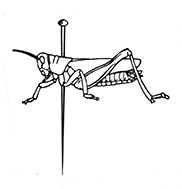
Stink bugs, squash bugs, and other true bugs: Pin through the V-shaped scutellum to right of the center line.

Scutellum – A shield-shaped design located on the back of Hemiptera (true bugs).
Bees, wasps, and flies: Pin through the thorax to right of the center line and slightly behind the base of the forewings.

Beetles: Pin through the right wing cover near its front attachment.
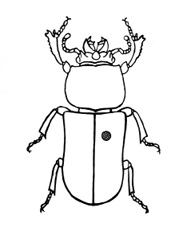
Moths, butterflies, and dragonflies: Pin through the middle of the thorax at the thickest point and slightly behind the base of the forewing.

You must spread the wings of moths and butterflies before they dry. To do this, you will need your spreading board.
Step 1: Pin the insect through the thorax as previously described.
Step 2: Insert the pin into the center block of the spreading board until the wings are level with the sides of the spreading board.
Step 3: Adjust the front wing by gently pulling it forward, with the aid of an insect pin, until the rear margin is at a right angle to the body of the insect. When moving the wing, your pin point should rest on the front margin of the wing. It is much tougher at this point, and there is less chance of its tearing. The wing can be temporarily anchored to the board by carefully inserting the pin through the wing membrane, directly behind the front margin.
Step 4: Pull the hind wing forward until the front margin is hidden beneath the front wing, and temporarily anchor the wing in the same manner as for the front wing.
Step 5: Once the wings are in position, place strips of paper over the wings, anchor them firmly to the board, and remove the temporary pins.
Step 6: Allow the specimen to remain in position for about a week before it is removed from the board. Some large specimens may take longer.
Card Point
As you have learned, this technique is used to mount those insects too small to mount directly through the body. The card point can be made by cutting it from a plain 3 x 5 card.
The base should be three-eighths of an inch wide. It is important that the point be to the left of the pin and the insect be attached by the right side. Use a tiny drop of clear nail polish to glue the insect to the tip of the card point.

Insect Labels
If your collection is going to be a source of information, it should be labeled. Your collection should contain the following three labels:
- Order. Place the order label in front of the first insect in that particular order as the insects are lined up in the box. It is usually placed flat on the pinning surface of the box and held in place by straight pins.
- Common name. The common name label gives the common name of the pinned insect. It is put under the insect on the same pin as the insect.
- Locality-date-collector label. This label contains the place (county) where the specimen was caught, the date it was collected (5/18/83), and the collector’s name (J. Doe). This three-eighths by three-fourths of an inch label is positioned on the pinning block.
The order labels are available through your county Extension office. When writing on labels, always use indelible or India ink.
You can arrange the specimens in your box in various ways. People usually start on the left side of the box and arrange the insects vertically under the appropriate order name. You should start with those orders that contain the fewest specimens and progress to those that contain the greatest number of specimens. Whatever method you use, it should be neat and systematic, and the labels should be easy to see and read.
List three types of labels that should be on your collection.
Level of Identification Required for 4-H Insect Collections
For 4-H insect collections, it is most important to identify insects to the proper order, and to identify insects by their accepted common name when possible. However, many insects do not have an accepted common name, even though they may have a scientific name (genus and species). In fact, some insects do not even have a scientific name—because they have not yet been officially described and recognized.
For 4-H insect collections, contestants are not required to include genus and species names in their collections. In fact, this is usually not required in many college-level entomology classes.
In cases where an insect cannot be identified by common name, contestants should attempt to identify specimens to the family level, and include the family name on the label that would normally contain the common name. It is also acceptable to use “general common names” in cases where you cannot determine the approved common name for a specimen. For example, “longhorned beetle” for cases where you know it is one of the longhorned beetles but cannot determine which species/common name, or “termite” for cases when you know it is a termite but are not sure which species of termite.
It is also acceptable to leave the common name label blank in cases where you simply cannot identify the insect to an accepted common name or family. Of course you would not want to do this for common, easily identifiable insects such as monarch butterflies or honey bees.
Don’t guess when making insect identifications. Don’t write a common name or family name on the label for a specimen unless you are reasonably sure of your identification.
What Groups of Arthropods Should Be Included in a 4-H Insect Collection?
4-H insect collections should only contain members of the class Insecta (28 orders) and Entognatha (three orders: Protura, Collembola, and Diplura). These three orders are still allowed because they were once classified as insects. Ticks, spiders, and other terrestrial or aquatic arthropods should not be included in a 4-H insect collection.
This gives a total of 31 possible orders that might be represented in a collection. See Extension Publication 2591 4-H Insect Identification Contest Study Guide for Senior 4-H’ers for a complete listing of insect orders.
Insect Collection Judging Criteria
- number of different orders represented
- total number of specimens in collection
- accuracy of identification, to order, and common name (if known), or family (identification to genus and species is not required or encouraged)
- uniformity of mounting and labeling
- neatness and arrangement
- condition of specimens
- correct size display box (19 x 16 ½ x 3 inches)
Some Common Insects of Mississippi
|
Common Name |
Order/Family |
|---|---|
|
American grasshopper |
Orthoptera/Acrididae |
|
lubber grasshopper |
Orthoptera/Acrididae |
|
redlegged grasshopper |
Orthoptera/Acrididae |
|
German cockroach |
Blattodea/Blattidae |
|
American cockroach |
Blattodea/Blattidae |
|
smokybrown cockroach |
Blattodea/Blattidae |
|
field cricket |
Orthoptera/Gryllidae |
|
mole cricket |
Orthoptera/Gryllotalpidae |
|
praying mantis |
Mantodea/Mantidae |
|
walkingstick |
Phasmida/Phasmatidae |
|
eastern subterranean termite |
Isoptera/Rhinotermitidae |
|
earwig |
Dermaptera/several |
|
chewing louse |
Phthiraptera/several |
|
hog louse |
Phthiraptera/Haematopinidae |
|
shortnosed cattle louse |
Phthiraptera/Haematopinidae |
|
head louse |
Phthiraptera/Pediculidae |
|
thrip |
Thysanoptera/several |
|
giant water bug |
Hemiptera/Belostomatidae |
|
leftfooted bug |
Hemiptera/Coreidae |
|
squash bug |
Hemiptera/Coreidae |
|
toad bug |
Hemiptera/Gelastocoridae |
|
water strider |
Hemiptera/Gerridae |
|
milkweed bug |
Hemiptera/Lygaeidae |
|
chinch bug |
Hemiptera/Lygaeidae |
|
yucca plant bug |
Hemiptera/Miridae |
|
tarnished plant bug |
Hemiptera/Miridae |
|
damsel bug |
Hemiptera/Nabidae |
|
harlequin bug |
Hemiptera/Pentatomidae |
|
green stink bug |
Hemiptera/Pentatomidae |
|
brown stink bug |
Hemiptera/Pentatomidae |
|
southern green stink bug |
Hemiptera/Pentatomidae |
|
wheel bug |
Hemiptera/Reduviidae |
|
lace bug |
Hemiptera/Tingidae |
|
whitefly |
Hemiptera/Aleyrodidae |
|
aphid |
Hemiptera/Aphididae |
|
leafhopper |
Hemiptera/Cicadellidae |
|
oak lecanium |
Hemiptera/Coccidae |
|
holly scale |
Hemiptera/Diaspididae |
|
euonymus scale |
Hemiptera/Diaspididae |
|
camellia scale |
Hemiptera/Diaspididae |
|
pecan phylloxera |
Hemiptera/Phylloxeridae |
|
periodical cicada |
Hemiptera/Cicadidae |
|
green lacewing |
Neuroptera/Chrysopidae |
|
anthion (doodlebug) |
Neuroptera/Myrmeleontidae |
|
drugstore beetle |
Coleoptera/Anonbiidae |
|
flatheaded appletree borer |
Coleoptera/Buprestidae |
|
fiery hunter (ground beetle) |
Coleopter/Carabidae |
|
cottonwood borer |
Coleoptera/Cerambycidae |
|
grape colaspis |
Coleoptera/Chrysomelidae |
|
elm leaf beetle |
Coleopteran/Chrysomelidae |
|
striped cucumber beetle |
Coleoptera/Chrysomelidae |
|
convergent lady beetle |
Coleoptera/Coccinellidae |
|
twicestabbed lady beetle |
Coleoptera/Coccinellidae |
|
Mexican bean beetle |
Coleoptera/Coccinellidae |
|
boll weevil |
Coleoptera/Curculionidae |
|
southern corn billbug |
Coleoptera/Curculionidae |
|
whitefringed beetle |
Coleoptera/Curculionidae |
|
sweet potato weevil |
Coleoptera/Curculionidae |
|
plum curculio |
Coleoptera/Curculionidae |
|
pecan weevil |
Coleoptera/Curculionidae |
|
carpet beetle |
Coleoptera/Derestidae |
|
eyed click beetle |
Coleoptera/Elateridae |
|
black-striped blister beetle |
Coleoptera/Meloidae |
|
striped blister beetle |
Coleoptera/Meloidae |
|
Bessbug (Betsy bug) |
Coleoptera/Passalidae |
|
June beetle |
Coleoptera/Scarabaeidae |
|
sugarcane beetle |
Coleoptera/Scarabaeidae |
|
rhinoceros beetle |
Coleoptera/Scarabaeidae |
|
southern pine beetle |
Coleoptera/Curculionidae |
|
rove beetle |
Coleoptera/Staphylinidae |
|
confused flour beetle |
Coleoptera/Tenebrionidae |
|
scorpionfly |
Mecoptera/several |
|
saltmarsh caterpillar |
Lepidoptera/Arctiidae |
|
carpenterworm |
Lepidoptera/Cossidae |
|
monarch butterfly |
Lepidoptera/Nymphalidae |
|
tomato pinworm |
Lepidoptera/Gelechiidae |
|
potato tuberworm |
Lepidoptera/Gelechiidae |
|
silverspotted skipper |
Lepidoptera/Hesperiidae |
|
saddleback caterpillar |
Lepidoptera/Limacodidae |
|
green cloverworm |
Lepidoptera/Noctuidae |
|
fall armyworm |
Lepidoptera/Noctuidae |
|
eightspotted forester |
Lepidoptera/Noctuidae |
|
bollworm/corn earworm/tomato fruitworm |
Lepidoptera/Noctuidae |
|
walnut caterpillar |
Lepidoptera/Notodontidae |
|
morningcloak butterfly |
Lepidoptera/Nymphalidae |
|
viceroy |
Lepidoptera/Nymphalidae |
|
red admiral |
Lepidoptera/Nymphalidae |
|
nantucket pine tip moth |
Lepidoptera/Olethreutidae |
|
orangedog (giant swallowtail) |
Lepidoptera/Papilionidae |
|
black swallowtail |
Lepidoptera/Papilionidae |
|
tiger swallowtail |
Lepidoptera/Papilionidae |
|
bagworm |
Lepidoptera/Psychidae |
|
wax moth |
Lepidoptera/Pyralidae |
|
regal moth (hickory horned devil) |
Lepidoptera/Saturniidae |
|
IO moth |
Lepidoptera/Saturniidae |
|
Cecropia moth |
Lepidoptera/Saturniidae |
|
polyphemus moth |
Lepidoptera/Saturniidae |
|
peachtree borer |
Lepidoptera/Sesiidae |
|
whiteline sphinx |
Lepidoptera/Sphingidae |
|
webbing clothes moth |
Lepidoptera/Tineidae |
|
holly leafminer |
Diptera/Agromyzidae |
|
blow fly |
Diptera/Calliphoridae |
|
sorghum midge |
Diptera/Cecdomyiidae |
|
mosquito |
Diptera/Culicidae |
|
house fly |
Diptera/Muscidae |
|
horn fly |
Diptera/Muscidae |
|
stable fly |
Diptera/Muscidae |
|
common cattle grub |
Diptera/Oestridae |
|
soldier fly |
Diptera/Stratiomyidae |
|
horse fly |
Diptera/Tabanidae |
|
crane fly |
Diptera/Tipulidae |
|
dog flea |
Siphonaptera/Pulicidae |
|
cat flea |
Siphonaptera/Pulicidae |
|
honey bee |
Hymenoptera/Apidae |
|
black carpenter ant |
Hymenoptera/Formicidae |
|
imported fire ant |
Hymenoptera/Formicidae |
|
odorous house ant |
Hymenoptera/Formicidae |
|
spider wasp |
Hymenoptera/Pompilidae |
|
cicada killer |
Hymenoptera/Sphecidae |
|
baldfaced hornet |
Hymenoptera/Vespidae |
|
eastern yellowjacket |
Hymenoptera/Vespidae |
|
carpenter bee |
Hymenoptera/Xylocopidae |
Learning Activities
To successfully conclude this unit of study, you should complete activities 10, 12, and 13. You can learn more from the study by completing any or all of the other learning activities.
- Write a brief report on the feeding habits of an insect.
- Prepare an exhibit of different kinds of insect nests, such as nests of the wasp, hornet, and bagworm.
- Prepare a club program on helpful and harmful insects.
- Make an insect collecting net.
- Make a kill jar.
- Make a spreading board.
- Make a relaxing jar.
- Make a pinning block.
- Give a visual presentation on the types of metamorphoses found in insects.
- Make an insect collection containing at least 50 different insects and at least 11 different orders.
- Give a visual presentation on making the equipment needed to prepare an insect collection.
- Give a visual presentation on pinning and labeling techniques.
- Complete a 4-H entomology record sheet.
Questions
- How would you pin a grasshopper and a stink bug?

- In what case would you use a card mount rather than the body-pin method?

Identifying Insect Body Structures (answers from first activity)
- Head
- Antenna
- Compound eye
- Mouthparts
- Thorax
- Legs
- Front wings
- Hind wings
- Abdomen
- Tympanum
- Spiracles
Appendix
Materials to Build a Standard 4-H Display Box
|
Part |
Quantity |
Materials |
Size (inches) |
|---|---|---|---|
|
A – end |
1 |
white pine |
¾ x 3 x 17 ½ |
|
B – end |
1 |
white pine |
¾ x 2 5/8 x 17½ |
|
C – sides |
2 |
white pine |
¾ x 3 x 16 ½ |
|
D – bottom |
1 |
plywood |
1/8 x 16 ½ x 19 |
|
E – pinning surface |
1 |
block foam |
½ x 15 x 17 ½ |
|
F – top |
1 |
glass |
1/8 x 16 x 18 1/8 |
Use paneling nails or small wood screws to secure the box. For construction details, see the illustration below.
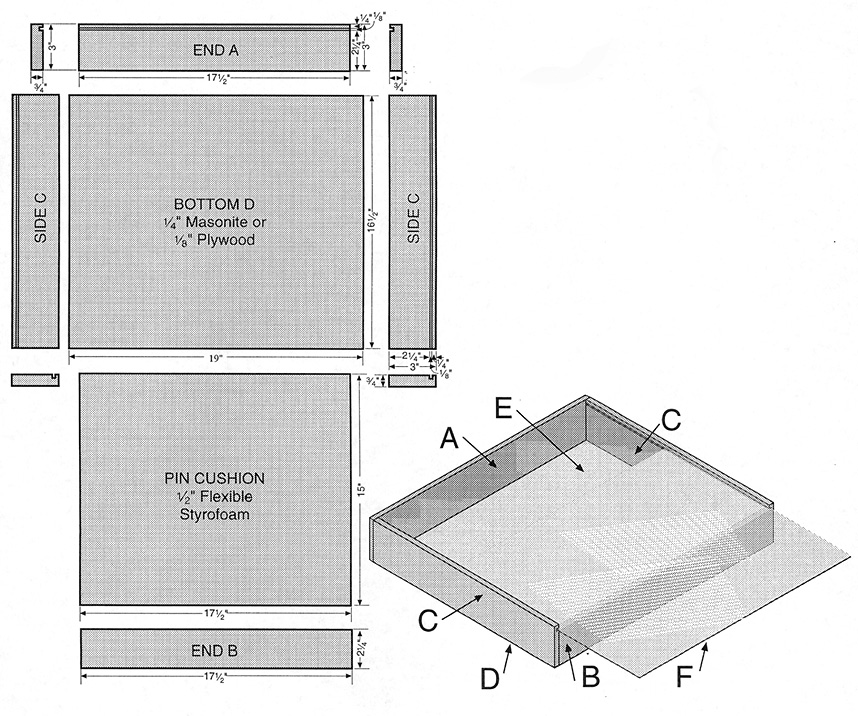
References
Field Guide to Insects and Spiders of North America, by Arthur V. Evans, 2007, National Wildlife Federation.
This field guide includes general information on the biology of insects, spiders, and related arthropods, along with color photographs and basic information for all insects listed in this study guide. The order classifications used in this guide are the same as those used in the 4-H Insect Identification Contest Study Guides. Other field guides and older editions can also be useful, but if you use such guides, be aware that they may use outdated or alternative order classifications.
4-H Insect Identification Contest Study Guide for Senior 4-H’ers, 2010, Mississippi State University Extension Service Publication 2591.
This publication contains a list of the 100 species of insects, orders of insects and related organisms, and other information that senior 4-H’ers (ages 14–18) need to know to compete in the 4-H Insect Identification Contest.
4-H Insect Identification Contest Study Guide for Junior 4-H’ers, 2010, Mississippi State University Extension Service Publication 2592.
This publication contains a list of the 50 species of insects, orders of insects and related organisms, and other information that Junior 4-H’ers (ages 8–13) need to know to compete in the 4-H Insect Identification Contest.
Common Names of Insects Database, Entomological Society of America, www.entsoc.org/common-names.
This database contains the officially accepted common names and current scientific names and classification for North American insect species. Note that there are many insect species that do not have common names.
Eastern Butterflies, by P. A. Opler, 1998, Peterson Field Guides.
This field guide contains information on the identification and biology of most species of butterflies found in the eastern United States.
Equipment Suppliers
Commercial sources for insect pins, display boxes, nets, and other insect collecting equipment.
BioQuip Products
(310) 667-8800
2321 Gladwick Street
Rancho Dominguez, CA
Carolina Biological Supply
www.carolina.com
1-800-334-5551
Ward’s Natural Science
www.wardsci.com
1-800-962-2660
Mississippi State University
Department of Entomology
(662) 325-2085
Usually has limited supplies of insect pins and insect collection display boxes available for sale to 4-H’ers.
Publication 317 (POD-08-22)
Revised by John Guyton, PhD, Associate Extension Professor, Biochemistry, Molecular Biology, Entomology, and Plant Pathology. Originally prepared by James Jarratt, PhD, Extension entomologist (retired).
